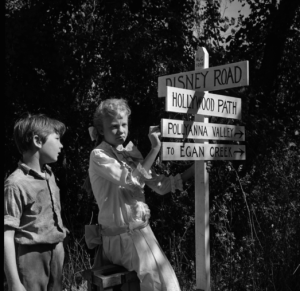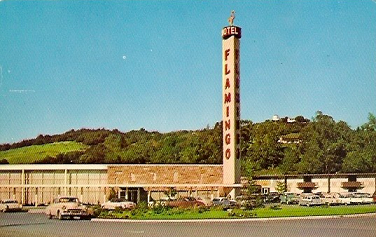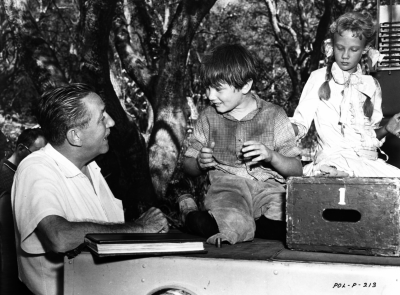 When Walt Disney decided to adapt Eleanor Porter’s novel Pollyanna into a live-action feature film, he needed to find the perfect location for Harrington, the turn of the century town that Pollyanna would forever transform into “the glad town.” Walt found the rural charm he was looking for in city of Santa Rosa, California, and in the surrounding countryside of the idyllic Sonoma and Napa Valleys. In July of 1959, the Pollyanna cast and crew members made the 500 mile trek north from the Walt Disney Studios in Burbank to the San Francisco Bay Area to begin the two months of on location filming.
When Walt Disney decided to adapt Eleanor Porter’s novel Pollyanna into a live-action feature film, he needed to find the perfect location for Harrington, the turn of the century town that Pollyanna would forever transform into “the glad town.” Walt found the rural charm he was looking for in city of Santa Rosa, California, and in the surrounding countryside of the idyllic Sonoma and Napa Valleys. In July of 1959, the Pollyanna cast and crew members made the 500 mile trek north from the Walt Disney Studios in Burbank to the San Francisco Bay Area to begin the two months of on location filming.
Santa Rosa and the newly constructed and ultramodern Flamingo Hotel (it was fully air conditioned!) became the base camp for the Pollyanna production crew. To enable the 125 members of the location company to get back and forth (sometimes as far as 50 miles) from the Pollyanna headquarters to the various filming sites, ten trucks, a fleet of automobiles, three limousines and two buses were in almost constant use. Two automobiles did nothing but shuttle back and forth between the headquarters and the San Francisco Airport, some 55 miles away, picking up passengers, delivering film, and receiving various pieces of equipment from the studio.
The Santa Rosa home of Mrs. Juilliard McDonald was selected as the imposing mansion belonging to Aunt Polly, played by Academy Award®-winning actress Jane Wyman. The McDonald Mansion (now known as Mableton Mansion) was built in 1877 by Col. Mark Lindsay McDonald, and is a two-story house with spacious lawns and gardens occupying an entire square block in the center of town. Col. McDonald was the owner of Santa Rosa's water company, builder of the Santa Rosa Street Railway, and one of the town's most eminent early citizens. He had his home built in a style to evoke the plantations along the Mississippi River, and the National Register of Historic Places (in which the mansion is listed) describes the style as Stick/Eastlake, a type of Victorian architecture. The mansion hosted many notable visitors throughout its storied history, including Mark Twain, railroad magnates Leland Stanford and Charles Crocker—and of course Walt Disney.
While the McDonald Mansion was only two stories, the dramatic needs of the film called for a larger home, so a third story was added to the mansion with a little movie magic, and the artistic talent of Disney matte painter Peter Ellenshaw. The crew transported the tree that Pollyanna climbs from the Studio in Burbank to Santa Rosa, and "planted" it in the already tree-filled McDonald mansion yard. The tree then returned to Burbank after location shooting was completed, so that it could be used for matching shots filmed on the sound stages at the Disney studio.
 Several citizens of Santa Rosa were recruited as “local talent” to play the members of the Ladies Aid Society. Macdonald Mansion owner Isabel McDonald was among them, as were her across-the-street neighbors,Santa Rosa Press-Democrat publisher Ruth Finley and artist Elizabeth Quant. Dressed in 1912-vintage full-length skirts and petticoats, they spent several long, sweltering summer days gathered on the lawn of the mansion. Another neighbor, Mrs. Finley’s aunt, Ruth Alexander, actually had a speaking part (saying said “Oh, the suffering in this world!”) as they sat packing calves’ foot jelly for the poor. It was pointed out at the time that Mrs. Alexander made four times the extras’ pay for that one line. The extras made $18 a day, including a group of children who played orphans, alongside Kevin “Moochie” Corcoran.
Several citizens of Santa Rosa were recruited as “local talent” to play the members of the Ladies Aid Society. Macdonald Mansion owner Isabel McDonald was among them, as were her across-the-street neighbors,Santa Rosa Press-Democrat publisher Ruth Finley and artist Elizabeth Quant. Dressed in 1912-vintage full-length skirts and petticoats, they spent several long, sweltering summer days gathered on the lawn of the mansion. Another neighbor, Mrs. Finley’s aunt, Ruth Alexander, actually had a speaking part (saying said “Oh, the suffering in this world!”) as they sat packing calves’ foot jelly for the poor. It was pointed out at the time that Mrs. Alexander made four times the extras’ pay for that one line. The extras made $18 a day, including a group of children who played orphans, alongside Kevin “Moochie” Corcoran.
The opening credits of Pollyanna were filmed at several locations in and around the Napa Valley town of St. Helena. The initial shot of a group of young boys swimming in the old swimming hole was filmed at the Sulphur Springs Railroad trestle at the entrance to town. Jimmy Bean, played by Kevin “Moochie” Corcoran, rolls his hoop with a stick through the Napa countryside on his way to the Harrington Railroad station. Along the way he passes the Bale Grist Mill, now a state historic park located three miles north of St. Helena. The water-powered grist mill was built in 1846 and was once the center of social activity as Napa Valley settlers gathered to have their corn and wheat ground into meal or flour.
We first meet Hayley Mills as Pollyanna arriving at St. Helena’s Southern Pacific Railroad Depot, which still stands today in the center of the town. The uninterrupted countryside of two private ranches, the Luer Ranch on Guerneville Road in Santa Rosa and the Egan Ranch (which was owned by the uncle of Richard Egan, who played “Dr. Edmund Chilton”) were also used in the film.
The foreboding home of Mr. Pendergast, "the meanest man in town," played by early movie star Adolphe Menjou in his final film role, was the historic Manor House at Stag’s Leap Winery in Napa. The two-story stone structure, with its distinctive corner tower, was built from rock of a nearby quarry around 1890, and has been featured in several films and the television series Falcon Crest. The Manor house sits at the foot of a 600-foot cliff, with the sheer wall running directly up from the house. The Stags Leap winery and region got its name, so an old legend goes, when a band of Indians, hunting for food, pursued a great white stag until it reached the cliff from where, rather than be killed by the Indians, the noble animal leaped to its death.
 A Disney press release at the time of filming summed up the scope of filming Pollyanna on location: “Filming on Pollyanna began in northern California, in and around the town of Santa Rosa and throughout the Napa valley, some 40 miles east of Santa Rosa. Two ranches, three homes, one railroad station, the Napa river, a pond which had to be filled by the local fire department because the drought had dried it up, an entire early-1900′s railroad train, two ancient 'horseless carriages,' a 100-year-old grist mill, a tree which was trucked some 500 miles from the Disney studio to Santa Rosa and back again, 30 sheep, 18 horses and six crates of live chickens were among the items used during location shooting.”
A Disney press release at the time of filming summed up the scope of filming Pollyanna on location: “Filming on Pollyanna began in northern California, in and around the town of Santa Rosa and throughout the Napa valley, some 40 miles east of Santa Rosa. Two ranches, three homes, one railroad station, the Napa river, a pond which had to be filled by the local fire department because the drought had dried it up, an entire early-1900′s railroad train, two ancient 'horseless carriages,' a 100-year-old grist mill, a tree which was trucked some 500 miles from the Disney studio to Santa Rosa and back again, 30 sheep, 18 horses and six crates of live chickens were among the items used during location shooting.”
In the decades since the filming of Pollyanna, much has changed as the Sonoma and Napa Valleys have evolved into internationally renowned winemaking regions and Santa Rosa as grown into a bustling city, but the simple beauty, charm, and community spirit found in the fictional town of Harrington live on in Pollyanna. Walt Disney’s film has become a family classic beloved around the world and reminds all of us to look for the good in life and to be glad.
Walt Disney was no stranger to the city of San Francisco or the greater Bay Area, visiting the region numerous times throughout his career. Over the years he visited the region to attend such events as the Golden Gate International Exposition of 1939 (which was held on Treasure Island in San Francisco Bay) and the premier of Fantasia at the Geary Theater in San Francisco. Many of the early ride vehicles for Disneyland were fabricated at Arrow Development in Mountain View, California—and Walt would frequently visit to inspect their progress and test ride the vehicles.
Joseph Titizian is an inaugural member of The Walt Disney Family Museum volunteer team. He is a regular contributor to this blog, and has developed continued education courses for the volunteer team. A lifelong Disney fan, Joseph has previously worked at Disneyland Park and Pixar Animation Studios
